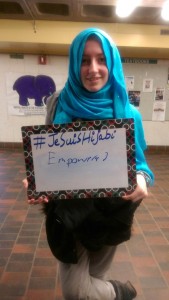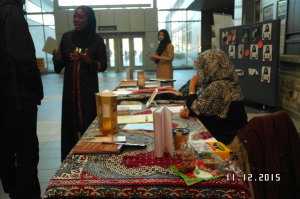Mansura Minhas
Richard Dawkins recently called upon Muslim women to shun their Hijabs as a show of solidarity with the victims of Paris attacks. Dawkins is an anti-theist, wholly ignorant to Islam. Thus, his case against the Hijab fits perfectly well in his anti-Islam narrative. However, when Muslim women — who take pride in their ‘feminist’ credentials — cite half-baked and fabricated definitions of ‘Hijab’ and join the club to make a case against a guidance clearly rooted in the Quran, they only succeed on placing Hijab wearing women in danger.
Not only do Asra Nomani and Hala Arafa undermine their own credibility, they are also propagating a false notion about a clear Qur’anic guideline. They demean and shame millions of Muslim women who adorn the Hijab willingly, as a fulfillment of Qur’anic teachings. For women who observe Hijab, it is not merely a piece of cloth, nor a symbol of defiance. Rather, it is a path that aids in self-purification and nearness to their Creator. It is a means to inculcate modesty. By choosing to wear Hijab, I feel liberated and empowered in the literal sense.
The authors assert Hijab as the sixth pillar of Islam–it isn’t. Anyone who has studied the basic tenets of Islam knows this. But digging into the Qur’anic teaching, the injunction about modesty starts by addressing men—not women. “Say to the believing men that they restrain their looks and guard their private parts. That is purer for them. Surely, Allah is well aware of what they do.” (24:31) Only after addressing men, subsequently, the Quran advises women: “And say to the believing women that they restrain their looks and guard their private parts and that they display not their beauty or their embellishment except that which is apparent, thereof, and that they draw their head coverings over their bosoms, and that they display not their beauty or their embellishment save to their husbands…”(24:32)
No doubt some men, and some women who observe the Hijab, bully non-observant women to comply. There is no Islamic justification for these actions. Such coercion is the result of corrupt people—not the Qur’an which instead declares, “There shall be no compulsion in religion.” (2:257)
The Qur’an never mandates that anyone may forcefully thrust Hijab upon women. Rather it is an outer garment that must be imbued with a spirit of modesty that should be inculcated within. The outwardly expression solidifies that core purpose. When Nomani and Arafa condemn backlash of some Hijab enforcers, they must concurrently refrain from emulating the very same strategy they detest, while judging those who observe Hijab. Otherwise, they further demonize and endanger women who choose to wear Hijab by promoting anti-Muslim sentiment.
The solution to men who oppress women is in better leadership, not in blindly changing the Qur’an. Regarding Hijab, the Khalifa of Islam and head of the Ahmadiyya Muslim Community advised, “Men should remember that they have not been given powers to police others and should restrain themselves. It is not for them to cover the heads of women from outside. Men are commanded to restrain their eyes; they should fulfill their own obligations. There is not even any commandment to forcibly cover the heads of Muslim women, let alone non-Muslim women. It is men like these who have hardline ideas.”
The authors likewise make a lame case that these Qur’anic commandments for Hijab were for a time when women were vulnerable to sexual harassment, implying that the modern world is devoid of that vice. Really? One can only lament at these false illusions. In reality women worldwide remain equally vulnerable to sexual harassment. In societies, where women have minimized clothing or head coverings, the statistics are equally staggering.
1 out of every 6 American women has been the victim of an attempted or completed rape in her lifetime. Domestic violence is the leading cause of injury to women, and every 9 seconds in America a woman suffers assault. These horrific facts are indicative of an undeniable reality that women of all ages and times have been vulnerable to abuse by men. This is one reason why the Qur’an first addresses men to cast down their eyes and not gawk at women for any reason. That is, the greater burden of Hijab is on men, not women. Sexual harassment is a pandemic that the world continues to face. It is certainly not one that ceased beyond sixth century Arabia.

Women who adorn the Hijab prefer to be judged beyond their embellishments, just like all other women. Canada’s #JeSuiHijabi campaign—where women voluntarily wear the Hijab in solidarity with Muslim women—has been a huge success and has galvanized this point with support from all walks of society. Hijab is not a symbol of sexual distraction, rather it is to the contrary. For millions of women, like me, who adorn the Hijab voluntarily, we demand respect and fair treatment.
We prefer to be judged by what’s inside our heads rather than what adorns it.
Follow Mansura on Twitter at @mansuraminhas














